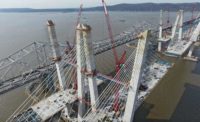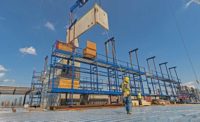Few of the 135,000 motorists crossing the Moses Wheeler bridge over Connecticut's Housatonic River in 2014 are expected to notice that the bridge is brand new. Few will likely realize that the Connecticut Dept. of Transportation (ConnDOT) and its project team on the 3,000-ft-long span between Stratford and Milford are on track to finish the bridge three years ahead of the 2017 target. But even though drivers may not focus on those details, they will benefit from the $350-million project that replaces the existing 54-year-old span that has reached the end of its useful life.
While ConnDOT has officially shaved off a year to set completion in 2016, the superstructure contractor joint venture of Walsh Construction, Chicago, and PCL Civil Constructors, Denver, aims to finish its $166.5-million contract to replace the Interstate 95 crossing by the end of 2014. This is the same team working 17 miles down I-95 on the $554-million extradosed-span Pearl Harbor Memorial "Q" Bridge in New Haven.
The 2014 target is "a self-imposed challenge by the joint venture," says Stephen DiGiovanna, ConnDOT District 3 supervising engineer. "It's almost like an accelerated schedule, but it's a goal they set themselves."
The Walsh-PCL contract has an incentive clause to remove traffic from the old structure by November 2014, which would trigger a $4-million bonus, says James Pelletier Jr., project engineer for ConnDOT. "The contractor wants to beat that by a year," he adds.
The team is demolishing the old bridge and erecting the new one in tight quarters that are bounded by a nearby Metro-North Railroad line, retail stores, local streets below the highway and an active marina.
Boaters below the Moses Wheeler, which is named for an early settler who ran the first ferry crossing the Housatonic nearly 400 years ago, may notice the new span's 13 pier lines, down from the original's 33. The most visible change for motorists will be a six-lane roadway widened to 136 ft from 92 ft, adding four full-width shoulders instead of the current 2-ft-wide breakdown lanes.
Early work to install 39 10-ft-dia foundations and a trestle for hauling 350-ton cranes went under a $60.5-million contract begun in 2009 and completed last year by O&G Industries, Torrington, Conn. The contract held by Walsh and PCL includes adding the first set of new concrete piers and steel decking while traffic continues to flow on the old bridge. A mix of strategic staging, night work and an adaptation of concrete deck installation techniques for steel are all contributing to the joint venture's goal for a faster schedule.
The state decided on a new bridge following a lengthy engineering review of the existing span. The original plan was for a $400-million budget on a replacement designed by STV Inc., but value engineering and other savings lowered it, DiGiovanna says. The Federal Highway Administration is funding 90% of the replacement project.
The project also covers three smaller single-structure spans that cross local streets. About half of the work takes place over the river, the rest over land, DiGiovanna says. The schedule has three roughly equal phases: first, erecting new lanes to the north; then moving traffic to that new portion, allowing the team to demolish and rebuild the southern side; and lastly, shifting traffic again to focus on removing and reconstructing the center portion.
The original design had concrete or steel options, and constraints on pier spacing made it appear concrete would prevail, says Gowen Dishman, resident engineer for HNTB. Walsh-PCL eventually proposed a workable erection method for steel, which helped lower the budget. "Market pricing and delivery cost for segments were the big difference," Dishman says. "The pieces would have to be trucked or barged in because we don't have room for fabrication, so it made concrete less competitive."
A late change to the foundation contract also may have saved up to a year, Pelletier says.
Raito, Hayward, Calif., was able to show how one of its rigs could dig four shafts that were originally slated for the second contract, because of concerns about potential damage to existing piers. Dishman says Raito was able to miss most piles from the existing bridge to install the 10-ft-dia steel casings.
After several overlapping months between the foundation and superstructure contracts, work began in December pouring concrete for land-based pier columns, pier caps and abutments, and installing the first 95,000-lb steel deck girders, says Curtis Beveridge, project manager for Walsh.
Superstructure work over the water is getting under way. It involves laterally launching steel from the existing deck and rolling pieces into position on carts and shoring towers. Most of that work takes place at night, when there is permission for lane closures, Beveridge says. The existing deck limits the size of crane you can use," he says.
The later stages allow for more traditional steel erection, including a gantry crane that will also aid demolition, Beveridge adds.
The team is already under scrutiny concerning crane operations after two accidents this year, according to news reports. The first in January involved a crane falling during transport, and another in April involved a boom toppling into a marina shed. A worker suffered broken ribs in the second incident, which led to a week-long ConnDOT-ordered work stoppage.
"We required them to retrain their workers and tradespeople," says Mark Rolfe, district engineer for ConnDOT. "It was contentious at first, but they addressed our concerns about the safety program. We're happy with the response from the Walsh/PCL team."
In addition to construction hurdles on the tight site, the proximity of businesses and the marina forced the team to limit dust, noise and environmental impact, DiGiovanna says.
"We even have some people who live on their boats," he adds. "It's one of our biggest challenges."
PROJECT TEAM Owner: Connecticut Dept. of Transportation Design Engineer: STV Inc. Contractor JV: Walsh Construction; PCL Civil Constructors Foundations contractor: O&G Industries Resident Engineer: HNTB Corp. Drilling Subcontractor: Raito Steel Erector: Walsh/PCL Steel Fabricator: Structal Bridges Pier ConcretE: Walsh/PCL Concrete Supplier: O&G Industries










Post a comment to this article
Report Abusive Comment